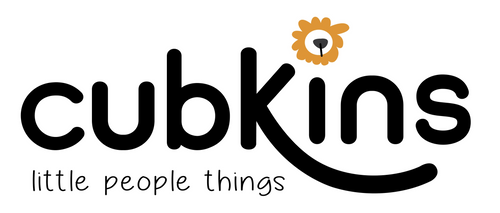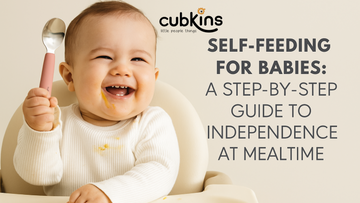Introduction
Your baby’s journey toward independence doesn’t just begin with their first steps; it actually starts much earlier, right at the dining table. When little hands reach for a spoon or try to grab food, it’s more than just mealtime, it's the beginning of self-feeding, one of the biggest developmental milestones.
For parents, watching this stage unfold is a mix of emotions. There’s pride in seeing your child take charge, but also a little anxiety about the mess that comes with it. Plates get tipped, food gets squished, and bibs work overtime but it’s all part of the process.
Self-feeding isn’t just about getting food from plate to mouth. It’s about your baby building fine motor skills, discovering independence, and learning to trust their own choices with food.
When Do Babies Start Self-Feeding?
Babies develop the ability to self-feed in stages, beginning with hand-feeding and gradually moving on to using utensils:
- 6-8 months: Babies start showing interest in grabbing food with their hands (this is a great time to introduce finger foods).
- 9-12 months: They begin using spoons, though they might still rely on their hands.
- 12-18 months: Improved coordination allows them to scoop food with a spoon and poke food with a fork.
- 18-24 months: Most toddlers can eat independently with utensils, though they might still make a mess.
💡 Tip: Don’t rush the process. Self-feeding is more about practice and learning than perfection.
Signs Your Baby Is Ready for Self-Feeding
Wondering if it’s the right time to introduce self-feeding? Look for these readiness signs:- Baby can sit upright without support
- Shows curiosity about your meals
- Reaches out for food or utensils
- Brings objects to their mouth with ease
-
Uses a pincer grasp (thumb and finger) to pick up small items

Choosing the Right Tools for Self-Feeding
When your baby begins self-feeding, the right tools can make all the difference. Imagine giving them a heavy metal spoon or a slippery plate frustration would set in quickly, and mealtime could turn into tears. But with baby-friendly utensils and smart mealtime gear, self-feeding becomes smoother, safer, and even fun. Each tool plays a role in helping your little one gain independence while keeping the mess (mostly) under control.
Soft Silicone Bendable Spoons (6+ months):
Think of this as your baby’s “first spoon.” Made from soft, gum-friendly silicone, these spoons are lightweight and perfectly sized for little hands still learning to grip. The bendable handle adjusts to different angles, so even if your baby doesn’t have perfect aim, they’ll still get food to their mouth. It’s a confidence booster during those early months when coordination is just beginning to develop.
Forks with Rounded Edges (12+ months):
As your child moves from purees to soft finger foods, a rounded-edge fork becomes their next step. Safe and gentle, it lets them spear foods like steamed veggies or soft fruits without the danger of sharp tips. Toddlers love the feeling of control when they can finally “pick up” their food, and these forks are designed to give them that success without any stress.
Spoon & Fork Sets with Travel Case:
If your baby is in daycare or you’re often eating on the go, these sets are lifesavers. A sturdy travel case keeps utensils clean in your diaper bag and ensures you always have safe, baby-sized tools handy. Dishwasher-safe and BPA-free options mean you don’t have to worry about hygiene or harmful materials just wash, pack, and go.
Stainless Steel Spoon & Fork for Advanced Self-Feeding
When your child gets a little older, they’ll want to use “real” cutlery just like the rest of the family. Stainless steel Spoon & Forks are the perfect bridge. They mimic the feel of adult spoons and forks but are still designed with rounded edges for safety. Lightweight and durable, they help your toddler feel included at the table, which often makes them more excited to eat.
Plates & Bowls with Suction Bases:
If you’ve ever had a baby flip their plate like a frisbee, you know why suction dishes are a game changer. These plates and bowls stick firmly to the highchair tray or table, meaning less food on the floor and more chances for your baby to actually practice scooping and picking up bites. They also come in sections, which is great for introducing new foods without overwhelming your child.
Silicone Bibs with Catcher:
Mess is inevitable, but a well-designed bib helps you manage it. Silicone bibs with a wide, deep pocket catch falling bites before they hit the floor. They’re soft, flexible, and wipe clean in seconds with no endless laundry or stained fabric bibs. For parents, that means less stress and faster clean-ups, and for babies, it means more freedom to explore without you hovering with a napkin.
Equipping your child with the right tools isn’t just about making meals easier, it's about building their confidence, encouraging independence, and giving them a safe space to learn. With the right spoons, forks, plates, and bibs, you’re turning mealtime into a joyful, hands-on experience that helps your baby grow.
How to Encourage Self-Feeding
Helping your baby become a confident eater requires patience, consistency, and encouragement. Here are practical ways to make it easier:- Start with Finger Foods: Soft fruits, well-cooked veggies, cheese cubes, or toast strips are perfect starters.
- Let Them Explore: Babies learn through touch and play don’t stress if food becomes a toy.
- Use the Right Utensils: Pre-load spoons or hand them easy-to-grip forks to practice.
- Eat Together: Babies imitate adults' mealtime is a great chance to model good habits.
- Keep Portions Small: Too much food can overwhelm; serve small bites and refill if needed.
- Embrace the Mess: Self-feeding is messy, it's a sign your child is learning. Use bibs and mats to make clean-up easier.
- Offer Choices: Simple decisions like “apple or pear?” give babies a sense of control.
Common Mistakes Parents Make with Self-Feeding
- Forcing Babies to Use Utensils Too Early: Some babies take longer to adapt; let them go at their own pace.
- Discouraging Messy Eating: Exploring textures is an essential part of the learning process.
- Overloading Their Spoon or Fork: Start with small amounts to prevent frustration.
- Expecting Perfection Too Soon: It’s okay if they use their hands for a while before mastering utensils.

The Benefits of Self-Feeding
- Develops Fine Motor Skills: Holding, scooping, and grasping food improves hand strength and coordination.
- Encourages Healthy Eating Habits: Babies who self-feed are more likely to enjoy a variety of foods.
- Builds Confidence and Independence: Giving babies control over their eating helps them feel more capable.
- Makes Mealtime More Enjoyable: When babies have the freedom to explore, they develop a positive relationship with food.
Conclusion
The journey to self-feeding is rarely neat; it's filled with dropped spoons, sticky fingers, and more food on the floor than in the mouth some days. But hidden in all that mess is something truly beautiful: your baby learning independence, coordination, and the joy of discovering food on their own terms.
By introducing the right tools at the right time and creating a calm, supportive environment, you’re doing more than teaching your child how to eat. You're helping them build confidence, motor skills, and a healthy relationship with food that will last a lifetime.
If you’re looking for a simple way to get started, the essential feeding set has everything your little one needs from baby-friendly utensils to suction-based dishes and easy-to-clean bibs designed to make mealtime less stressful and more enjoyable for both of you.
So take a deep breath, embrace the spills, and celebrate every small win. Each messy moment is a step toward your baby becoming a confident, independent eater.
FAQs
1. Is self-feeding safe?
Yes, as long as you offer age-appropriate, soft foods and supervise meals. Always avoid high-risk choking foods and cut foods into small, manageable sizes.
2. Should I let my baby use their hands instead of utensils?
Yes! Using hands first is an important stage in self-feeding. It builds confidence and improves coordination. Utensils can be introduced gradually while still allowing hand use.
3. What if my baby refuses self-feeding?
Refusal is common in the beginning. Offer a mix of spoon-fed meals and opportunities for self-feeding. Keep mealtimes fun, avoid pressure, and let your baby explore at their own pace.
4. How do I know my baby is ready for utensils?
Signs include attempting to scoop, poking food with fingers, and showing interest in your cutlery. Many babies show readiness around 12 months, but self-feeding readiness varies.
5. Is gagging normal when babies start self-feeding?
Yes. Gagging is a protective reflex and different from choking. It helps babies learn how to move food safely in their mouths. Always supervise mealtimes during self-feeding.
6. Can babies choke while self-feeding?
Choking is a risk at any age, but safe food choices reduce it. Avoid whole grapes, popcorn, nuts, and hard raw vegetables. Always supervise during self-feeding.

